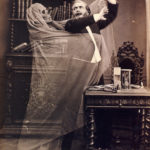Candles and prayer requests: Anglican transductions
Hi all – wanted to share some excerpts of my essay this week for my blog post:
There is an ontological problem posed when we try to communicate with the invisible, immaterial, and silent world of religious spirits, gods, or ancestors. How can we understand speaking to things beyond our phenomenal and material experiences, and how do we interpret a reply? Keane’s (2013) paper ‘On spirit writing: materialities of language and the religious work of transduction’, offers one solution to how communications with realms beyond human perception can be understood through what he calls “spirit-writing”. Spirit-writing works by acting on the materiality of written words to pass messages across the ontological plain which separates the phenomenal and the noumenal in religious contexts. This often takes the form of materialising something immaterial, or dematerialising something material (Keane, 2013; p. 2). This act of transforming text across “semiotic modalities” is what Keane defines as transduction (ibid; p. 9-10).
Prayer books and votive candles are sometimes a feature of Anglican churches as they constitute a form of devotional practice, private prayers conducted by Anglican Christians to foster spiritual growth and connection with God. These prayers take place outside of routine church services, and often involve praying for the recently deceased or for the well-being of friends and family. Sometimes these prayers or wishes will be written down in the chapel book, and a votive candle lit.
These forms of devotional prayer are examples of transduction for the following reasons: firstly, the act of writing prayer down represents a form of transduction, as the prayer passes between the semiotic modalities of inner thought to written text, and secondly the lighting of a candle (a highly symbolic and equally important part of the devotional practice) represents further transduction through the transformation of the substance of prayer from inner thought and written text, to physical substance and sign.
In writing, the message of devotional prayer is passed from the individual inner thought (the realm of the mind or the conscious awareness) into physical and written form in the book. In line with Keane’s theory of transduction, this act emphasises the sense of movement across semiotic modality. Writing also acts to cement the prayer in the physical world. The intentions of the act of prayer therefore extend beyond the single instance of devotion to have a longevity within the chapel itself. Adding prayer into the book offers the suggestion for future congregants to read through the book and continue your prayer themselves (even if they do not know who or what they are praying for).
The lighting of the candle preceding prayer is also highly symbolic. The flame acts to transform the substance of prayer across semiotic modalities, signalling not just a movement from inner thought to written word, but also from inner thought to physical sign. The prayer candle is often lit from a central one, symbolising how your prayers are in a sense fuelled from the light of the church, or the flame of God. Even though devotional practice is a highly personal act, it is still supported by the church and its congregation as a source of religious energy. The lighting itself is a transformation, as Keane would say is typical of transduction practices, from invisible and immaterial to visible and material. The lighting acts to materialise the private dialogue between the congregant and God – providing a tangible element to the prayer and to the experience of God as a real presence.
Finally, the lighting of the candles also involves the ingestion of substance. This is another feature of transduction, as Keane references that many Islamic and Jewish traditions of spirit writing include techniques of ingesting text – such as producing potions from the ashes of scriptural passages or infusing liquids with written texts. While we don’t often eat candles in church, the smell of smoke and burnt incense is a striking experience entering a chapel such as this. It is a part of the church experience, and we can see through this case that the smell of burnt devotional candles in a sense is the experience of inhaling prayer, the ingestion of the religious devotion and worship of others into our bodies – very tentatively I would like to argue that perhaps we could interpret this as God’s reply.
Contributed by HeidiCooke on 03/02/2022






